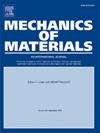Two competitive ignition mechanism for dynamic extrusion-shear loaded high-energy propellant
IF 3.4
3区 材料科学
Q2 MATERIALS SCIENCE, MULTIDISCIPLINARY
引用次数: 0
Abstract
Tactical missiles frequently experience accidental drops, impacts, and other events during maintenance and battlefield operations, subjecting their internal high-energy propellants to complex loads like extrusion-shear, which can trigger ignition and pose safety hazards. This study aims to elucidate the ignition mechanism of high-energy propellants under extrusion-shear and establish a predictive method. Firstly, a visualized extrusion-shear experiment was designed to directly observe the whole process of deformation, damage and ignition of GRT propellant. By adjusting the gap size, the correlation between overall flow deformation and local ignition mechanisms was explored. Secondly, a thermo-mechanical coupling model and a macro-micro perspective ignition criterion were integrated into the LS-DYNA subroutine to simulate local ignition responses under extrusion-shear loading and compare them with other ignition criteria. The results show that the fracture surface extending from the gap divides the sample into flow and stagnant regions, forming a slip surface at the boundary. As the gap size decreases from Φ3 × 23 mm to Φ1 × 1 mm, the ignition mechanism transitions from viscous external friction to viscous internal friction, altering the viscous frictional heating rate and resulting in distinct threshold velocities. The macro-micro-scale ignition criterion based on the viscous internal friction mechanism effectively describes the ignition behavior of GRT propellant under narrow gaps, and compared to other ignition criteria, provides the closest match with experimental results, demonstrating excellent universality.
动态挤压-剪切加载高能推进剂的两种竞争点火机制
战术导弹在维护和战场作战期间经常经历意外掉落、撞击和其他事件,使其内部高能推进剂承受挤压剪切等复杂载荷,这可能引发点火并构成安全隐患。本研究旨在阐明高能推进剂在挤压剪切作用下的点火机理,并建立预测方法。首先,设计了可视化挤压-剪切实验,直接观察了GRT推进剂的变形、破坏和点火全过程。通过调整间隙大小,探讨了整体流动变形与局部着火机理之间的关系。其次,在LS-DYNA子程序中集成了热-力耦合模型和宏观-微观视角点火判据,模拟了挤压-剪切加载下的局部点火响应,并与其他点火判据进行了比较。结果表明:从裂隙向外延伸的断裂面将试样划分为流动区和停滞区,并在边界处形成滑动面;随着间隙尺寸从Φ3 × 23 mm减小到Φ1 × 1 mm,点火机理由粘性外摩擦转变为粘性内摩擦,改变了粘性摩擦升温速率,产生了不同的阈值速度。基于粘性内摩擦机理的宏微尺度点火判据有效描述了窄间隙下GRT推进剂的点火行为,与其他点火判据相比,与实验结果吻合最密切,具有良好的通用性。
本文章由计算机程序翻译,如有差异,请以英文原文为准。
求助全文
约1分钟内获得全文
求助全文
来源期刊

Mechanics of Materials
工程技术-材料科学:综合
CiteScore
7.60
自引率
5.10%
发文量
243
审稿时长
46 days
期刊介绍:
Mechanics of Materials is a forum for original scientific research on the flow, fracture, and general constitutive behavior of geophysical, geotechnical and technological materials, with balanced coverage of advanced technological and natural materials, with balanced coverage of theoretical, experimental, and field investigations. Of special concern are macroscopic predictions based on microscopic models, identification of microscopic structures from limited overall macroscopic data, experimental and field results that lead to fundamental understanding of the behavior of materials, and coordinated experimental and analytical investigations that culminate in theories with predictive quality.
 求助内容:
求助内容: 应助结果提醒方式:
应助结果提醒方式:


